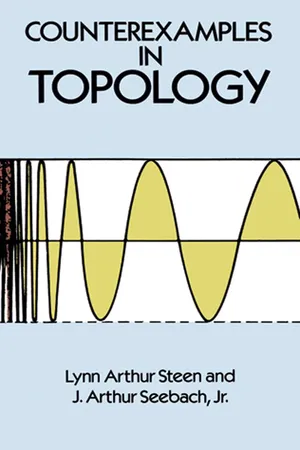
- 272 pages
- English
- ePUB (mobile friendly)
- Available on iOS & Android
Counterexamples in Topology
About this book
According to the authors of this highly useful compendium, focusing on examples is an extremely effective method of involving undergraduate mathematics students in actual research. It is only as a result of pursuing the details of each example that students experience a significant increment in topological understanding. With that in mind, Professors Steen and Seebach have assembled 143 examples in this book, providing innumerable concrete illustrations of definitions, theorems, and general methods of proof. Far from presenting all relevant examples, however, the book instead provides a fruitful context in which to ask new questions and seek new answers.
Ranging from the familiar to the obscure, the examples are preceded by a succinct exposition of general topology and basic terminology and theory. Each example is treated as a whole, with a highly geometric exposition that helps readers comprehend the material. Over 25 Venn diagrams and reference charts summarize the properties of the examples and allow students to scan quickly for examples with prescribed properties. In addition, discussions of general methods of constructing and changing examples acquaint readers with the art of constructing counterexamples. The authors have included an extensive collection of problems and exercises, all correlated with various examples, and a bibliography of 140 sources, tracing each uncommon example to its origin.
This revised and expanded second edition will be especially useful as a course supplement and reference work for students of general topology. Moreover, it gives the instructor the flexibility to design his own course while providing students with a wealth of historically and mathematically significant examples. 1978 edition.
Frequently asked questions
- Essential is ideal for learners and professionals who enjoy exploring a wide range of subjects. Access the Essential Library with 800,000+ trusted titles and best-sellers across business, personal growth, and the humanities. Includes unlimited reading time and Standard Read Aloud voice.
- Complete: Perfect for advanced learners and researchers needing full, unrestricted access. Unlock 1.4M+ books across hundreds of subjects, including academic and specialized titles. The Complete Plan also includes advanced features like Premium Read Aloud and Research Assistant.
Please note we cannot support devices running on iOS 13 and Android 7 or earlier. Learn more about using the app.
Information
| O1: | The union of open sets is an open set. | |
| O2: | The finite intersection of open sets is an open set. | |
| O3: | X and the empty set Ø are open sets. |
| C1: | The intersection of closed sets is a closed set. | |
| C2: | The finite union of closed sets is a closed set. | |
| C3: | X and the empty set Ø are both closed. |






Table of contents
- Cover
- Title Page
- Copyrights Page
- Preface
- Content
- Part I Basic Definitions
- Part II Counterexamples
- Part III Metrization Theory
- Part IV Appendices